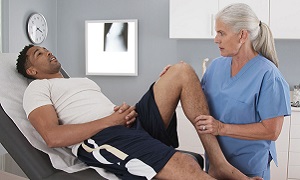Sciatica
When the pain spreads out from the sciatic nerve, it is Sciatica. The pain generally boards from the lower back i.e. from hips and buttocks towards the legs. This is the pain that usually affects one side of the body. It mostly occurs when the nerves are compressed by a bone spur on the spine, narrowing of the spin or herniated disk. This can often leads to pain, inflammation, and numbness in legs.
Causes of Sciatica
There are many causes that can lead to sciatica. The person can be affected by the same because of age, obesity, increased sitting, and diabetes. The main cause of sciatica is that the nerve becomes strained by the overgrowth of the bone or herniated disk. Other than this sometimes the nerve can get constricted by a tumor or damage that is caused by the disease.
Symptoms of Sciatica
The symptoms that can help you to understand if you are suffering from sciatica are:
- You might experience pain in your lower body parts, which starts from buttocks and will affect legs. Though you can experience discomfort in your nerves in any part of it.
- Some people might experience numbness in their legs. They might undergo weakness in the muscles.
- The patient suffering from sciatica might also suffer from burning sensations and extreme pain.
- Other than these, the person might also suffer from cough and sneeze. These symptoms might become worse.
Diagnosis of Sciatica
Your doctor may examine your reflexes and muscle strength during the physical examination. He or she may ask you to walk on your toes, or rise from a squatting position. If you are suffering from sciatica then the pain will get worse while performing these activities.
Imaging tests
Some people have bone spurs or herniated disks that are visible on the X-rays or some other imaging tests but don’t show any symptoms. Your doctor won’t recommend this test until you suffer from severe pain or a pain that doesn’t improve in some weeks’ time.
X-rays
Your doctor may recommend an x-ray of your spine to check for the overgrowth of the bone called bone spur. These bone spurs may press on a nerve.
MRI
Your doctor will use powerful radio and magnet waves for producing the cross-sectional images of your back. It produces detailed images of the bone and the soft tissues like herniated disks. You will lie on a table that moves into the MRI machine during the test.
CT Scan
Your doctor will use Computed Tomography to image the spine. He or she will inject a contrast dye into the spinal canal prior to the shooting of X-rays. This procedure is a CT myelogram. The dye will circulate around your spinal nerves and spinal cord that appears white-line on the scan.
Electromyography
Electromyography or EMG measures the electrical impulses that your nerves and the responses of your muscles produce. The test helps to confirm nerve compression due to herniated disks or due to the narrowing down of the spinal canal called spinal stenosis.
Treatment options for Sciatica
Medications
Physical Therapy
Steroid Injections

Surgery
Home Remedies
Sciatica deteriorates by self-care measures in most of the measures. You may experience some relief upon resting for a day or two. However, prolonged activities will simply worsen your signs and symptoms.
Cold packs: You may initially experience some relief from a cold pack that you place on the painful area for nearly 20 minutes several times a day. Wrap an ice pack or a package of the frozen peas in a clean towel.
Hot packs: Applying heat to the areas that hurt, after three days, also works as a remedy. You may try using a heat lamp or hot packs, or a heating pad on the lowest setting. You can also use hot and cold packs alternatively, if you still have pain.





